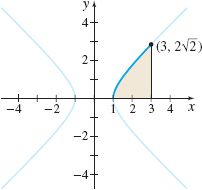EXAMPLE 6Use Trigonometric Substitution to Find a Definite Integral
Find the area under the graph of y=√x2−1 (the upper half of the right branch of the hyperbola y2=x2−1) from 1 to 3. See Figure 9.

Solution The area A we seek is A=∫31√x2−1dx. The integral contains a square root of the form √x2−a2, where a=1, so we use the trigonometric substitution x=secθ, 0≤θ<π2, π≤θ<3π2. Then dx=secθtanθdθ. Since the upper limit x=3 does not result in a nice angle (θ=sec−13), we find the indefinite integral first and then use the Fundamental Theorem of Calculus.
With x=secθ and dx=secθtanθdθ, we have A=∫√x2−1dx=∫√sec2θ−1secθtanθdθ=∫tanθ⋅secθtanθdθ=∫tan2θsecθdθ
Since tanθ is raised to an even power and secθ to an odd power, we use the identity tan2θ=sec2θ−1.Then A=∫√x2−1dx=∫tan2θsecθdθ=∫(sec2θ−1)secθdθ=∫sec3θdθ−∫secθdθ=12[secθtanθ+ln|secθ+tanθ|]−ln|secθ+tanθ|+C=12secθtanθ−12ln|secθ+tanθ|+C
∫sec3θdθ=12[secθtanθ+ln|secθ+tanθ|]. Either integrate by parts, or use the reduction formula.
Now we express tanθ in terms of x=secθ, and apply the Second Fundamental Theorem of Calculus. A=∫31√x2−1dx=↑secθ=xtanθ=√x2−1[12x√x2−1−12ln|x+√x2−1|]31=32√8−12ln(3+√8)=3√2−12ln(3+2√2)